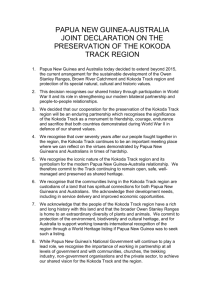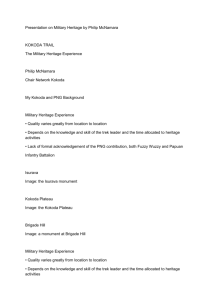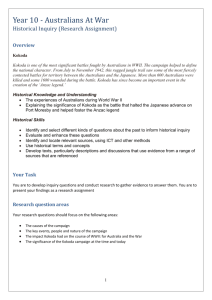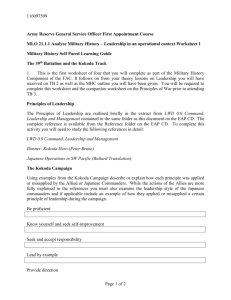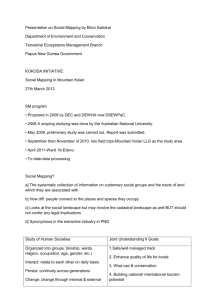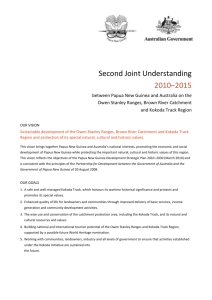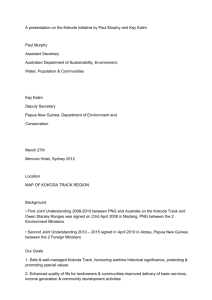Track or Trail - Adventure Kokoda Niusleta
advertisement
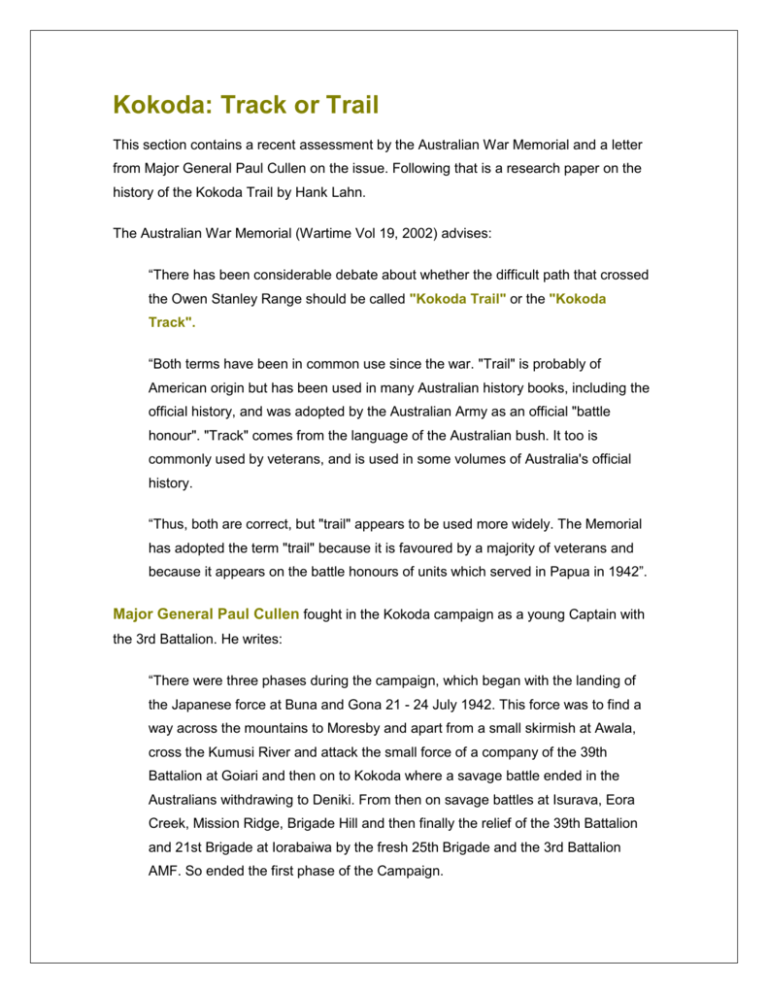
Kokoda: Track or Trail This section contains a recent assessment by the Australian War Memorial and a letter from Major General Paul Cullen on the issue. Following that is a research paper on the history of the Kokoda Trail by Hank Lahn. The Australian War Memorial (Wartime Vol 19, 2002) advises: “There has been considerable debate about whether the difficult path that crossed the Owen Stanley Range should be called "Kokoda Trail" or the "Kokoda Track". “Both terms have been in common use since the war. "Trail" is probably of American origin but has been used in many Australian history books, including the official history, and was adopted by the Australian Army as an official "battle honour". "Track" comes from the language of the Australian bush. It too is commonly used by veterans, and is used in some volumes of Australia's official history. “Thus, both are correct, but "trail" appears to be used more widely. The Memorial has adopted the term "trail" because it is favoured by a majority of veterans and because it appears on the battle honours of units which served in Papua in 1942”. Major General Paul Cullen fought in the Kokoda campaign as a young Captain with the 3rd Battalion. He writes: “There were three phases during the campaign, which began with the landing of the Japanese force at Buna and Gona 21 - 24 July 1942. This force was to find a way across the mountains to Moresby and apart from a small skirmish at Awala, cross the Kumusi River and attack the small force of a company of the 39th Battalion at Goiari and then on to Kokoda where a savage battle ended in the Australians withdrawing to Deniki. From then on savage battles at Isurava, Eora Creek, Mission Ridge, Brigade Hill and then finally the relief of the 39th Battalion and 21st Brigade at Iorabaiwa by the fresh 25th Brigade and the 3rd Battalion AMF. So ended the first phase of the Campaign. “The second phase, the advance of the 3rd Battalion and the 25th Brigade and the 16th Brigade from Iorabaiwa to the Kumusi River and beyond to Soputa; finally driving the Japanese into prepared fortress style defences at Buna, Gona and Sanananda. “This became the third phase known as the Battle of the Beaches. The most bitter battles were at Gona and Buna. Sanananda was more of a siege with the enemy well dug into dugouts heavily reinforced with logs and some concrete. Casualties were very heavy at Sanananda more to malaria; dysentery and sandfly fever than bullets and bayonets. It was eventually mopped up in mid January 1943 by the Australians who cleared Papua of the enemy. “The winding path between Koitaki in the south and Buna, Gona in the north passes through many villages and camps on its tortuous way across the spine of the Owen Stanley Range and at its highest point reaches 7,000 feet at Templeton's Crossing all in the shadow of Mr Victoria at 14,000 feet. All through thick rainforest and impenetrable jungle. “Prior to WW11 according to tales told by the 'the old hands' miners, planters et al, all paths, tracks etc were called by the direction one was going, eg. Moresby Road, Buna Road, Kokoda Road. “During the campaigns of 1942-43 Milne Bay, Owen Stanleys, Wau, Salamaua, the War Correspondents were camped at the 7 Mile Airstrip and had to send their censored reports to Australia by cable. This entailed describing the battles along the way as huge enemy losses at Imita-Efogi-Myola. As there was no morse sign for the word 'hyphen' the word had to be signalled letter by letter in morse code making the account payable by the sender twice as high. One enterprising journalist, Geoff Reading was a keen fan of the tales of Tales of the Klondike by Jack London and others began using the word 'Trail' to refer to where the fighting was taking placed, eg. 'on the Kokoda Trail near the village of Efogi' or whatever. Our troops overcame stiff opposition etc. The editors back in Australia loved it and soon it became known as 'The Kokoda Trail'. Soldiers actually still fighting in New Guinea were receiving letters from home containing love and kisses and ' we hope 2 you are not on that terrible Kokoda Trail'. Anyone wanting to confirm this has only to go to the Mitchell Library and see copies of newspapers of that period. Meanwhile those who were still there on the 'Trail' especially the walking wounded were told to take the Moresby Road. “At War's end when Battle Honours were being handed out, or should I say bestowed, those units which had been involved in the Owen Stanley Campaign were all awarded Kokoda Trail; except the 39th Battalion who insisted having one word 'Kokoda' as they were the only unit which fought there. There were no objections at that time and none since although these last few years some people are saying that 'Trail' is an American word. “In 1972 the Papua New Guinea Government set up a Place Names Commission, which named the way across the Owen Stanleys 'The Kokoda Trail'. During their investigations they discovered that all the Australian Survey Corps Maps being printed in late 1942-43 names it the 'Kokoda Trail' and that in 1932 the wife of a planter on the Sogeri Plateau had written a book about the mountain trail and she named the book 'The Kokoda Trail'. “Major General Kingsley Norris, the Medical Director of the 7th Division at the time who had traversed it more than anyone else, setting up rest and dressing stations for the wounded, wrote of it, 'Time, rain and the jungle growth will eventually obliterate this native pad; but forever more will live the memory of weary men who have passed this way and ghosts of glorious men who have gone, gone far beyond the Kokoda Trail. General Norris' description of the 'native pad' is worth reading in the pages of 'Retreat from Kokoda' by Raymond Paul, Chapter 6." History of The Kokoda Trail - A research paper written by Hank Nelson The Kokoda Trail was first used by Australians in the 1890s to reach the Yodda goldfield on the upper Mambare. In 1899, in a three-month patrol, the government surveyor, H.H. Stuart-Russell, marked and mapped the track.1 3 Although other government officers had previously passed through the area, StuartRussell confronted several groups looking for the chance to attack. On the northern side of the Owen Stanleys near the Mambare 'the fight began'. The warriors soon found their shield no protection against rifles, but 'they came on again and again with the usual bravery of all natives belonging to that district (and) they were repulsed every time with loss.2 Stuart Russell, who had previously served in the Northern Division, commented that from the Yodda to the Opi the 'tribes' were 'numerous, warlike and treacherous'.3 The violence continued through the next three or four years with the language of war being used, government officers and police being openly attacked and sometimes they killed 30 or 40 Orokaiva.4 It was not simply government versus villagers: in confused battles, armed miners, controlled and uncontrolled labourers and clans seeking alliances with foreigners fought each other in what was both a continuation of traditional warfare and a transformation of it as the contestants, weapons and rules of war changed. North of Isurava and beyond Kokoda the track passed through the area of the greatest violence in the history of Australian pacification of Papua, and all that disruptive fighting was within the memories of people alive in 1942. Stuart-Russell decided that a road could be cut through the Gap to Kokoda, but that it would cost 10,000 (pounds sterling) and take two years. The lack of any road over 100 years later suggests that he was optimistic.5 The trail came into regular use once Kokoda stations was established in 1904. Replacing Papaki (Papangi) and Bogi, Kokoda was, a visitor said in 1906 a 'radiant spot' and the Resident Magistrate's house 'native, rambling and picturesque'.6 The site, C.A.W. Monckton reported, was selected partly because it allowed 'regular and rapid' communication with Port Moresby'.7 The mail service carried by members of the Armed Native Constabulary connected Port Moresby to Kokoda, and that service, often timed to coincide with the boat from Australia, continued into 1942. The police, sometimes one from the north and one from the south meeting halfway to exchange mail bags, were so confident of the track that they travelled at night. In 1929, the police mailmen were involved in one of Papua's best-known murders. In a dispute over whose turn it was to carry the mailbag, Armed Constable Karo shot and killed Armed Constable Bili.8 In 1906, two of the Royal Commissioners sent to enquire into the administration of British New Guinea and to make recommendations for Australian Papua walked all the 4 way from Buna to Kokoda and on to Sogeri where they picked up horses and rode into Port Moresby. Charles Herbert was 46 years old and Kenneth Mackay 47. Handicapped by a 'gammy ' leg, Mackay took in good part when he saw cheerful Orokaiva imitating the way he lifted his leg over fallen logs. After a few days walking, Mackay admitted that 'a policeman did not carry (his) revolver and water bottle, for in a land like this even a grasshopper would become a burden.9 When the fired Royal Commissioners arrived at Sogeri in 1906, David Ballantine's coffee plantation was almost alone in production on the plateau. Ballantine, the government treasurer, had had his hill station sideline for nearly 10 years, but the first rubber had just been planted. By 1940, there were four main plantations on Sogeri with Koitaki (2,180 acres planted) and the British New Guinea Development Company plantation at Itikinumu (1,559) by the far the largest.10 By recruiting in the heavily populated and close Northern Division, the Sogeri plantations increased movement across the Kokoda track. Time-expired indentured labourers walking home often carried rubber seedlings with them. In 1938, Clen Searle, then living near Kokoda, counted 11,000 village trees in the area, and applied to tap them.11 In 1908, the Seventh Day Adventists established a base at Bisiatabu, a small Sogeri plantation, to begin the conversion of the peoples of Papua to another religion and another calendar. Pastor Sptimus Carr first walked to Kokoda in 1913, and he began compiling a Koiari dictionary and teaching the Koiari schoolboys and labourers at Bisiatabu.12 But is was not until Pastor Lock arrived in 1924 and he and Albert Bateman built the station at Efogi that the Adventists were established on the track. The Lock family took six days to walk to their new home. By 1926, the Efogi stations was home to the William and Molly Lock, their four children, nurse Emily Heise, and the Fijian missionary, Nafitalai Navara and his family. Everything from the mattresses, stove, galvanised iron for a water catchment and 20 goats had been carried or shephered along the track.13 Eight-year-old Lester Lock was the youngest of the Lock family to walk unaided to Efogi. Seventy-eight years later, and with many trips along the track intervening, Lester was asked to go back to Efogi for the dedication of a church to be named after him. He regretfully declined.14 Lois, six years old in 1924, was probably the first wounded Australian to be carried back along the track - she fell, broke her arm and was stretchered out to be checked by a doctor. After the Locks left Efogi in 1926, 5 Charles and Evelyn Mitchell moved into the mission house, and when they left Nafitalai and then Faole, A Kioari convert took over.15 By 1940, LesterLock had completed his training in Australia, returned to Papua, and been appointed to Bisiatabu. Taking advantage of the new and dangerous road cut past Rouna Falls, Lester had a printing press trucked to Bisiatabu. Koiari texts could now be printed on Koiari land. In and 1941, Lester made several patrols into the Koiari villages, and he wa at Efogi when a runner travelled through the night to bring him news that the Japanese had attacked Pearl Harbout. All the Locks - William and his family then living at Mirigeda on the coast east of Port Moresby and Lester and his family - were in Australia before the start of the Kokoda campaign.16 William Lock's second son, Maynard, who enlisted in the army in Queensland in 1942, was a lieutenant in the Australian army by the end of the war, his fluency in Papuan languages being used in broadcasts from Port Moresby.17 Before 1942, the Adventists were the only Australians who had learnt the Koiari language, and they had converts and ex-Bisiatabu students through many of the villages.18 The 'occasional missionary' on the track was likely to have been a Seventh Day Adventist - or his wife or children. For 30 years the Adventists had been coming and going from Bisiatabu, and sometimes living at Efogi, almost half way between Sogeri and Kokoda.19 In 1923, Miss Phillippa Bridges was probably the first white woman to walk the length of the Kokoda Track. Bridges, the sister of the Governor of South Australia, Sir George Bridges, began walking from below Rouna Falls at what was then the end of the road from Port Moresby, and she, C.R. Pinney from the Papuan Administration, a police escort and carriers took eight days to reach Kokoda. They then continued to Buna where they caught the government boat, the Elevala. Her fortnight was all, Miss Bridges said, a 'splendid experience', and it had been accompanied with much 'good-fellowship' that had made it 'so enjoyable.20 War stimulated movement in Papua and New Guinea, and after the Japanese landed at Rabaul in January 1942 it certainly increased traffic on the Kokoda Track. As the demand for labour in Port Moresby and on the rubber plantations (then being pushed to maximum production) increased, Australian New Guinea Administrative Unit (ANGAU) field officers were told to shift from persuasion to conscription. For many of the old civil officers, it was a distressing change from being the neutral guardians of the labourers to 6 taking men from weeping families, holding them under guard, and chasing those who attempted to desert. Because of the high population and the fact that the recruits did not have to wait for scarce shipping, in the Northern District officers were set high quotas. 21 Tom Grahamslaw, then a captain in Angau, sent 500 men over the track in April, and was immediately told to recruit another 500.22 Gerald Brown, a patrol officer at Kokoda, reported sending smaller groups across under escort, and a few, having deserted and walked home, were making a third journey to hard labour.23 Australian civilians escaping or enlisting walked through Kokoda and on to Port Moresby. The planter Clen Searle from Awala plantation went to Port Moresby to enlist in the Papuan Administrative Unit (later part of Angau), walked back and, when told rubber was needed urgently, gathered 200 labourers and supervised the carrying of his stock of bales over the track to Sogeri. Again he walked home. His escape just ahead of the advancing Japanese was his fifth crossing in 1942.24 A Japanese pilot, captured in the Northern District, was escorted over the track in June, and he made it all the way to Port Moresby.25 Bibliography 1 British New Guinea Annual Report (hereinafter Annual Report), 1898-99, reprints a detailed report, pp.41-45 1 Annual Report, 1898-99, p43. 2 Ibid., 44 3 Hank Nelson, Black, White and Gold: goldmining in Papua New Guinea 1878-1930 ( Canberra 1976), Ch 9. 4 Annual Report, 1898-99, p.44 5 Kenneth Mackay, Across Papua: being an account of a voyage round, and a march across, the Territory of Papua , with the Royal Commission ( London 1909), 115 6 Annual Report, 1905-5, p. 34 7 Amirah Inglis, Karo: the life and fate of a Papuan ( Canberra 1982, 22-30 8 Mackay, Across Paua, 123-4 9 David Lewis, The Plantation Dream: developing British New Guinea and Papua 1884- 1942 ( Canberra 1996), 309 10 Ibid., 227 note 11 Alfred Chapman, 'Breeding new ground - Part 2', Journal of Pacific Adventist History, 7 1:2 (2001), 9. 12 Lester Lock, Locks that Opened Doors (privately pub 2000). 13 Lester Lock in e-mail to Hank Nelson 14 McCarthy, South-West Pacific Area, 596-7, has an account of Lieutenant R. McIlroy and party who were helped by Adventist converts. McIIroy ahd met Faole (Lock, Locks that Opened Doors, 40-1). 15 The SDA mission then had a staff of 10 Eoropeans and several Solomon Islanders in Papua: R.W. Robson (ed.), The Pacific Islands Year Book (Sydney 1942), 31. 16 Geoff Basket, Islands and Mountains (privately pub. N.d.), 85; Ian Mackay, Broadcasting in Papua New Guinea ( Melbourne 19765), 8-9 17 John Garrett, Where Nets Were Cast' Christianity in Oceana since World War 11 (Suva and Geneva 1997), 36 18 Lance Taylor, Snake Road : a guide to the history, people and places of the Sogeri District (Sogeri 1992), 146 19 Phillippa Bridges, 'Afoot in Papua, 1923', Proceedings of the Royal Geographical Society of Australasia, South Australian Branch, Session 1923-4, Vol XXV, pp. 29-56. 20 Under Angau the Papuan Divisions followed New Guinea practice and were called 'districts'. All of Papua and New Guinea was now known as Australian New Guinea. 21 Tom Grahamslaw, reminiscences, Pacific Islands Monthly, Mar. 1971, p. 141. 22 Brown, diary, 28 Apr. 1942, Canberra , Pacific Manuscripts Bureau, mf, PMB1162. 23 Jessie Lillian (Pat) Searle, Memini . (I Remember) Recollections of my life . (privately pub. n.d.), 182-6 24 Grahamslaw, reminiscences, 141. Alan Hooper, Love War and Letters, PNG 1940-45 (Cooparoo 1994), 102 8
